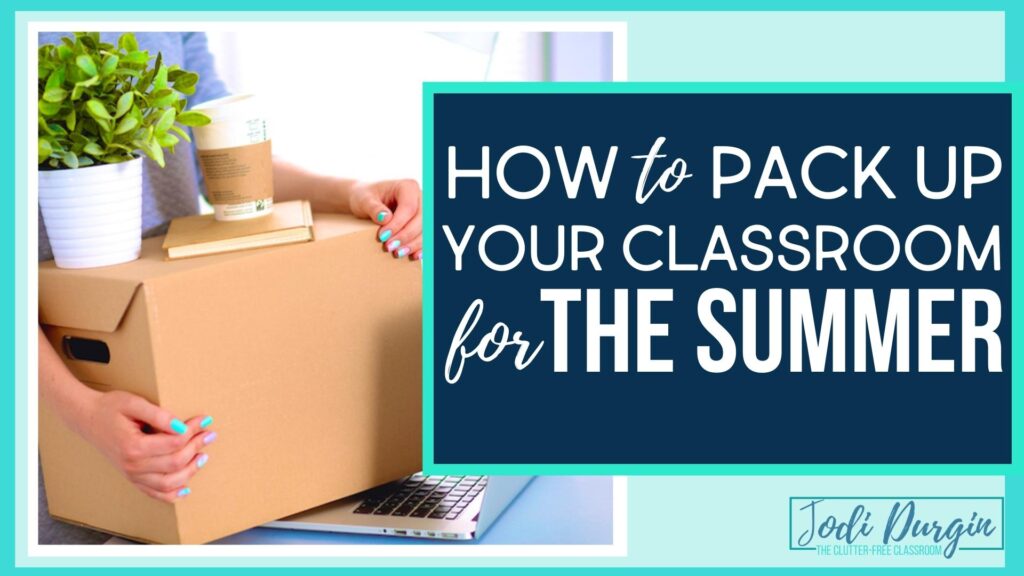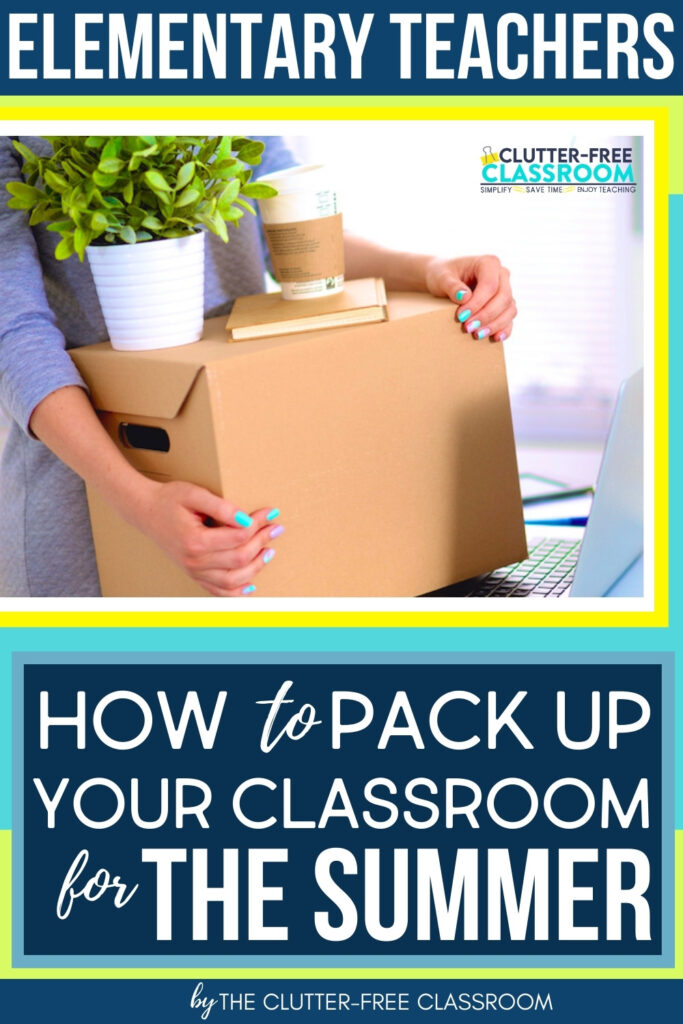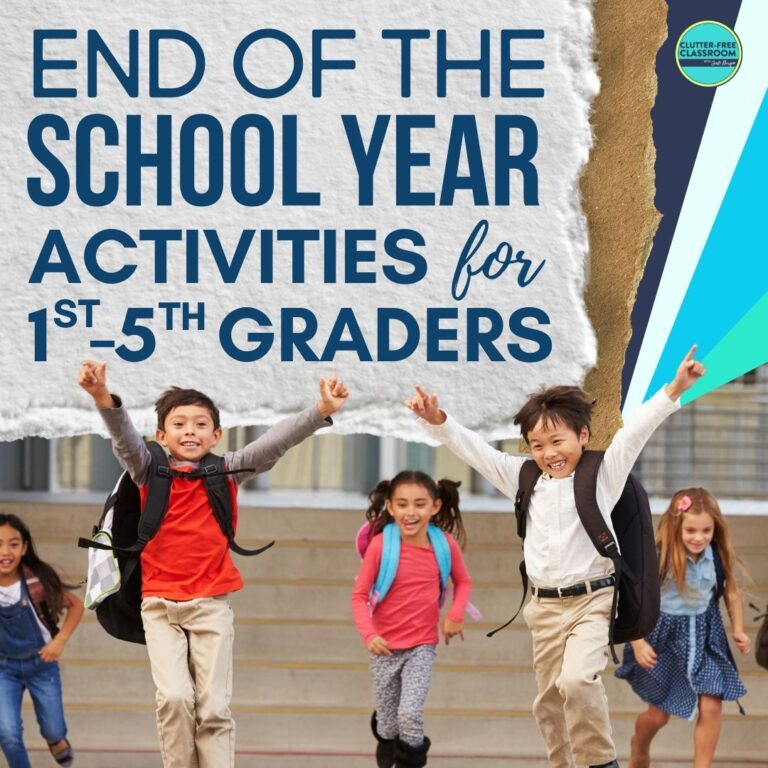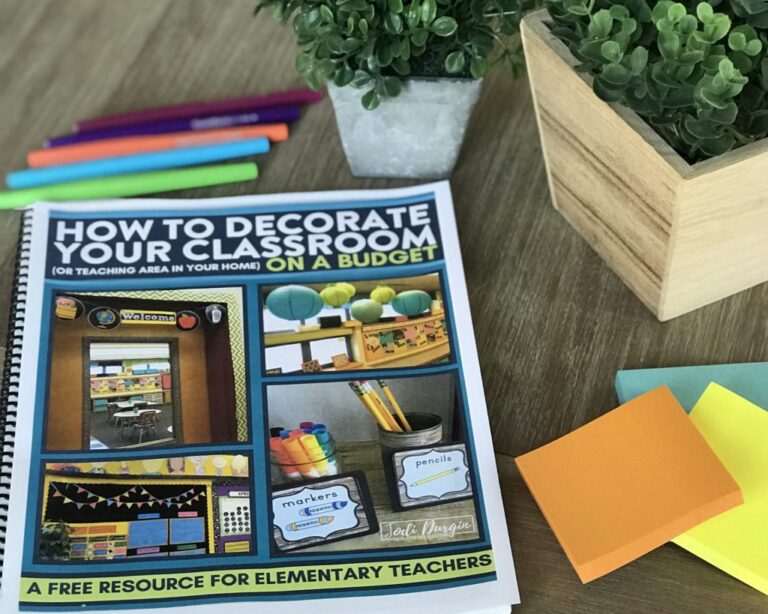Before I get into how to pack up your classroom, I have to know: Have you started your countdown? Be honest… Did you start it in January?
Summer vacation is so close you can feel it! Many of you will LITERALLY feel it soon because your classroom does not have air conditioning. You’ll have a classroom full of hot and sweaty children who are just as ready for summer as you are. Sound familiar? When that happens, turn those lights off and put that little fan you brought from home on full blast. Those are the signs that you’re almost there!
As you try to survive the hustle and bustle of the end of the school year, remember to set aside time to pack up your classroom for the summer so you can leave on your final contracted day and get a jump start on your well-deserved summer vacation. Yahoo!
Over time, I have developed a 4 step system for how to pack up your classroom at the end of the school year. These simple steps will help reduce stress at the end of the year and kickstart your summer. Read below to learn more!

4 Steps for How to Pack Up Your Classroom
Below are 4 simple steps for how to pack up your elementary classroom.
Step 1: Purge Your Clutter Before Packing
The first step for how to pack up your classroom is to purge. The more you get rid of, the less you need to manage and organize. This will be especially helpful in the fall when you come in to start the new year. You want to start off recharged and refreshed and not frazzled and overwhelmed. As you go through the items, don’t look at the items you have with “retail value” eyes.
Instead, look at them as “what value do they have to me?” An item that is free may actually come at a price, that price being your sanity, your space, or your time.
When someone gives you something and it’s in perfect condition, it can seem like a waste to throw it out. It’s hard to part with it. However, it will be a burden if you don’t use it. If you are on the fence about parting with something, consider giving it to a colleague who can use it and borrow it from them if or when you need it. Chances are you won’t.
Below are some things to consider when you pack up your classroom.
Get containers for the items coming home with you.
This would include personal items that you want to keep safe along with curriculum you may want to use for planning over the summer. I recommend clear, plastic tubs because they are sturdy, offer a defined (translation: limited) amount of space and you can see inside easily. Put these items into the designated tubs as you come across them. You won’t lose them in the shuffle as a result.
Get big, sturdy, trash bags.
I like the contractor bags from Home Depot. You may be placing heavy objects inside and you won’t have time for picking up the contents of ripped bags.
Gather boxes for donations/giveaways.
Copy paper boxes work well. They are uniform in size and have lids. You can easily stack them because of these characteristics.
Talk to your principal about designating a space for giveaways.
At this time of year, many teachers are purging. See if you can set up a table outside your classroom for other teachers to pick from or perhaps even in the teacher’s room or work room. Send an email to the staff letting them know that there will be items available throughout the week.
Set aside extra time in your schedule.
If you can, go back to the classroom to work at night or extra early in the morning. Your mind will be clear and you will have less distractions.
Enlist the help of a “runner.”
This can be a friend, former student, etc. Have that person take the items from you to their new spots (trash, recycle, donate, take home, etc) and scurry back to you for the next item. This will save you lots of valuable time because you’re attention can remain focused on the act of purging while your runner can be in charge of simply moving things along.
Pick a starting point and quickly work your way around the room until you get back to the starting point.
Be brutal about what you choose to keep. Remember an item is only valuable if it is of use to you and your students. If you come across an item that is a duplicate to another you already own keep only the better one.
Go around a second time once you make it all the way around.
This time will be faster, but you’ll find that you will want to get rid of things that made the “first cut” after giving it another glance.
Remove the unwanted items from your space immediately.
As soon as a container is filled, remove it from your space immediately. Again, this is where having a runner will save you lots of time. As your space becomes cluttered with boxes/bags you’ll feel more overwhelmed. Keeping the space as clear as possible will help a lot.
Break the room into zones and set time limits.
You can break is down to one wall or even one shelf. You can decide what works best for you. Work to music and challenge yourself to finish before a song ends. Set a timer and “beat the clock”. The need to move fast helps keep the overwhelmed feeling away.
Step 2: Pack Up the Materials
The second step for how to pack up your classroom is to pack up the materials. Packing up for the summer is one of those topics that I find varies greatly by school. I am fortunate that my classroom remains mostly intact. The summer cleaning crew does remove all the furniture to clean the rugs and floors so I usually move all non-furniture items up onto counters and shelves, but otherwise my stuff can stay put. However, I know many teachers who have to pack EVERYTHING into boxes that are in storage for the summer. I have even encountered teachers that take it all home. Pick and choose from the ideas below for how to pack up your classroom so that you can find what relates to your unique situation.
Snap photos.
If you are happy with your classroom and intend to set it up the same way in the fall, be sure to take pictures before you begin packing things up. Take them from all angles. Document the placement of items on shelves. Make life even easier by keeping them on your phone so they are easily accessible when you come back to set up. Do this before you pack a single thing.
Use clear tubs for take-home items.
I always recommend packing the items you’ll be taking home for the summer (curriculum to use for lesson plans, personal items, etc) in clear, plastic tubs. It’s easy to see what you have. They are sturdy. You can reuse them. Most importantly, they are much better at keeping moisture away and protect the contents than boxes or open crates. This is important because although you pack it up with intention of getting lots done in the summer, these boxes often find their way into basements and garages and are forgotten until the fall. You want to be extra careful with district-owned materials.
Create a “need right away” box.
Make the box easy to find by using bright paint or paper on it to stand out. Put in only those items you’ll need when you initially walk into your classroom to start setting up in the fall (staples and a stapler for bulletin boards, scissors, things you’ve bought to decorate the classroom, etc). You may want to include cleaning supplies in this box.
Create a “personal” box.
Use it to house all of your photos, knick-knacks, etc. Put it somewhere safe and out of reach.
Think about how your classroom will be used.
Will your room be left alone in the summer? Will another teacher be using it for summer school? Is it possible that people will have access to your things? This will determine how much you need to pack away. If you have anything of value, you’ll want to find a place to secure it. If you are just concerned about others “borrowing” your things, you can simply put them in a box and secure it with duct tape or tie it with string that would need to be cut to access. This will deter unwanted borrowing.
Take inventory.
Be aware of what you have and what you’ll need more of. I created a FREE resource a couple years ago for my blog readers and TPT store customers titled The Ultimate Back-To-School Shopping List. Feel free to print it and keep it handy when packing so that you are prepared for the summer sales.
Keep like items together.
You want to be efficient when you set up your classroom for the new year. Don’t make your future days more challenging by shoving things into random boxes now. Have a plan. Pack with unpacking in mind.
Label and color code your boxes.
When my family moved to our current home, I purchased colored packing tape that was labeled with the words designating their destination (bathroom, kitchen, bedroom, etc). Awesome invention! Use colored tape, paper or paint to mark your boxes. This is especially important if you are moving classrooms or schools.
Number your boxes.
Record a number onto each box and quickly jot down the contents. I recommend using a computer or notes on a tablet or phone. This will make it easier to prioritize your unpacking.
Keep district-owned materials in one location.
In the unlikely event that something prevents you from returning to the classroom in the fall (unexpected illness or accident, spousal job transfer, last minute school/classroom change), it will be helpful to have everything that belongs to the school separated from your own materials. This is especially important if you are one of those teachers who needs to pack EVERYTHING before leaving.
Step 3: Get the Classroom Ready for Summer Break
The third step for how to pack up your classroom is to get the space ready for summer break.
Leave a map.
Avoid having your cleaning crew drag all the furniture into the hall and then just plop it back in anywhere by leaving a map or pictures. They clean lots and lots of rooms and I’m sure to them, they all start to look the same. If you want the furniture returned to your choice location, draw an easy-to-read map and/or leave photos. I’ve seen teachers sketch it out on the whiteboard, but I think taping them to your door is the best place to leave them.
Leave your photos.
One of my tips in step two was to take photos of your classroom so you can see where everything goes. These pictures can be helpful to the custodial staff as well. Print them and hang them on the door. Don’t forget to include a note of gratitude.
Label.
I love labels in any situation, but when it comes to summer at school it is extremely important. Oftentimes, the cleaning crew drags everything into the hall from several classrooms. They do this so they can clean many rooms at once. Increase the likelihood that you’ll get back your own tables, chairs and other furniture by labeling each piece. Painters tape works great for this because it peels off without residue. I recommend labeling it with your name and room number.
Clean.
You’ll need to “reclean” in the fall, but a quick dusting, wipe and shine now will make that process easier. Be sure to remove any food items from the classroom to prevent unwanted pests. This especially applies to lockers, cubbies, desks and any other nooks and crannies of the classroom where your little cherubs may have accidentally left a snack.
Pull the shades.
If your classroom will not be in use over the summer, pull down your shades to keep the sun from fading materials.
Store cords and cables.
The cleaning crew may need to move computers and other technology around. Avoid losing important pieces by removing them and storing them together. You’ll want to store the pens and eraser from your interactive boards in this location as well.
Move everything off of the floors.
Use counter space to hold baskets and smaller furniture items. This will make the cleaning crew’s job easier. Your belongings are also less likely to break or go missing.
Roll up rugs.
Secure the rolled rug with duct tape. This ensures it doesn’t come undone when it is moved.
Team up with a friend.
Many things are easier moved and prepared with extra hands. Have a colleague work with you in your room and then return the favor in their room.
Protect student confidentiality.
Make sure student records, reports, notes, tests, etc are all relocated to a safe and secure location. Shred documents that can be shredded.
Cover boards and open shelves.
Prevent damage and dust by covering open shelving and displays before you leave. Plastic trash bags are a great option to use for this task because they can be reused for their intended purpose after the summer.
Step 4: Prepare for Next Year
The final step for how to pack up your classroom is to prepare the space for next year. If you’ll be returning to the same classroom in the fall, there are several steps you can take if you have the time that will make things easier when you come back.
Prepare bulletin boards
Hang fabric and borders. Having fabric and border will make the classroom look neat and ready.
Take measurements
Measure shelves, tables, closets, desks, boards, wall space, etc. Keep these measurements handy, such as in your purse or on your phone so you can use them during the summer. They’ll be useful for planning how you want to set up your room and also for when you are out and about looking to buy containers or make projects.
Label
If you have a class list before you leave, you can prepare name tags, cubby labels, and any other items that you’d like to label with names. Even if you don’t hang them it will be nice to have them in the room and ready to go and not cluttering your house all summer.
Create files
I always encourage teachers to use a number system instead of student names where appropriate. Obviously you don’t want their cubby reading “Student #19” as that seems extremely impersonal and unwelcoming, but your files, student folders, book bags, parent communication note files, etc, can be set up with numbers. Go ahead and do that now.
Copy and prep
Beat the crowds at the copiers and laminators. Make copies and prep materials for next year. Take advantage of parent volunteers who have proven to be competent and helpful at tasks like these and ask them to lend a hand. This is especially useful if you have taught the same grade in the past and know what you’ll be using.
Enlist student help
Have some student volunteers stay after school to help with some off jobs. Kids are great at checking puzzles for lost pieces, organizing craft supplies, testing markers, sharpening pencils, and completing similar tasks.

20+ Tips for Packing Up Your Classroom
I hope you found the 4 steps above for how to pack up your classroom helpful! Below there are a compilation of ideas. Readers generously shared them through the CFC Facebook Page. I always love reading the responses to the questions over there! It’s amazing how different teaching is in different states and districts. The tips below were in response to a question about packing and moving a classroom.
- “Our district’s teacher’s union is doing a “free to new teachers” garage sale. They are collecting anything any teacher doesn’t want at the end of the year and housing it until early August when they are inviting new teachers to come shop for FREE. I think this is a great idea.” – Anne
- “A lot of good advice here, but be careful about the students you ask to help and make sure you give them clear instructions or else you’ll be REDOING all their work! I have learned this the hard way.” – Jennifer
- “Get the BIGGEST plastic tubs you can find and label, label, label. Middle school kiddos love to help & LOVE movie gift cards.” – Mike & Mary
- “I had a week to go through floor to ceilings of what a retired teacher left me. Save yourself and label boxes once packing is done. While going through items now, get rid of whatever you won’t use. It will save you time in those 3 days. If you can’t get through box, store it up high and get to it when you can.” – Alana
- “Labeling, Colored dots to indicate subject areas, something to indicate whether boxes are priority (teacher’s desk, things for back to school), everything that is not used at beginning of year goes home. Everything that you need to sort out goes home. Only 1-2 hard copies of any papers. Do it gradually if possible – I stayed after school 2 hours a night for a month so that I would keep my sanity and stamina. Give yourself rewards for doing this hard work. Use one or two really good helpers. Have lots of tape and lots of sizes of boxes and tubs. Good luck!!” – Mary
- “After 39 years of teaching I just do my best. Sometimes I have loaded it up and gone through it at home. Not my husbands fav but it saves my sanity! Good luck!” – Eileen
- “I helped my mentee clean out his room by emptying all his cabinets into piles in the floor by subject. We then sorted trash and give-aways to other grade levels, then put everything away in a place that makes sense. I think it had been at least 10 years since some cabinets had been cleaned out!” – Stacy
- “I’ve moved a lot over the yrs too, plus having to pack everything & store it elsewhere while walls were being built in our Pod (finally- a classroom with 4 walls after 16 years!). We did all that was previously mentioned, but there are custodians in our buildings all summer painting and doing repairs, so we can get in if we really need too. She should go to her union… 3 days is not enough time and she’s doing it for free, to benefit the kids! They should be able to give her extra days, just ask!” – Rebecca
- “My administration made lots of changes for the comming year. What we have done is band together and work together and WORK to get all of this done. We have one teacher who refuses to move, though. A small group is moving her, while the rest of us move each other.” – Katherine
- “I had to move grade levels and buildings within my district last year this time. We had to pack my entire classroom before the end of the school year. I was lucky to have two instructional assistants who literally saved me!! I cannot believe how many boxes we packed by the end of the year. It was a wall of boxes. My kiddos did great with it, we didn’t start until the last two weeks of the year. And in the summer I did a lot of the initial unpacking so I could put stuff where I thought I wanted it. But I enlisted help from former students (middle school age) who spent a day unpacking, sorting, labeling things. They were happy to help and enjoyed a pizza lunch on me. I have throw out and purged a lot this year and now I will have to do it again as I clean up and get ready for year two in the new bldg next year.” – Jennifer
- “I use bins from home depot that are strong and sturdy and can be nested once empty. Also I can zip tie the top so no one can get into it. I love to get curriculum items and then redirect them to the grade level that needs it.” – Genevieve
- “I sought help from my personal children and school children the last two days of school. My school children really liked helping move books, count textbooks, and sort school supplies. My personal child liked getting to come to school (she was out) and helping organize. All of my school belongings are now packed and ready to move-but I have to wait for floors to be refinished before moving.” – Jennifer
- “I have to wonder, if she’s a 20 year veteran herself, how much of these materials will she actually use? She most certainly has her own stuff, and a way of doing things that works. I started going through every page of materials left by a teacher who died suddenly. It felt disrespectful to get rid of it, but at the end of the day, I have my own things I haven’t used in years, and I wasn’t going to abandon what I was doing and start using what she left. I kept a few things as memories of her, left things out for a few days for others to take if they wished, and then made lots of trips to the dumpster.” – Heather
- “I took stuff home I’m moving classrooms and wanted to organize everything I had… Much more work, but when I return in the fall, all ill have to do is put items back on the shelves- shouldn’t take too long to set back up.” – Courtney
- “Plastic bins are king! We have to pack up every last paperclip each year. I would say sort first like items and then toss into bins what you want. Toss what is junk or outdated (there is always some) and then leave what’s left and send out an email to everyone to come and get or it’s going to goodwill. Or into another classroom that is getting a new teacher as a surprise?” – Kim
- “The retiring teacher in my building opened up her room and said take what ever we wanted. She cleared a lot of the big things out just by doing that.” – Heather
- “We have to pack our entire classroom up every year and bring what is ours home. It cannot be left. And we are not allowed to start until the kids leave for summer- then we get 2 days. It can be done just label everything!” – Pam
- “Our high schoolers need Community Service points. I’d call and enlist a few of them.” – Eileen
- “Host an open house for new teachers in the district to come in and grab what they want.” – Susan
- “As a ping pong ball that moved every year. I would get the older kids to help. Paid them with junk food. Also I got teachers kids who were in high school. They will do a lot for 20 bucks. It’s movie money.” – Julie
- “Many of the parents in my area do not have money to give a gift for the end of the year. I spoke with our room parent and asked to send out a letter to parents with the option of the end of your gift to me being 2 hours of help after school during that week. I organized myself with a list of tasks I knew would take 2 hours… Several of these parents even take the things home that I want to toss for their own kids. It’s a win-win!” – Gretchen
- “Last year over 70% of our elementary staff were reassigned to different grades or buildings, but we knew on May 11 that we were moving. Students love to pack… Are there any students in the building that can still help. My husband and inlaws helped a lot too. The hardest part was I had to move all my stuff home. Our dining room was filled all summer. Then the fun was moving it back in! Ugh! Having boxes for specific items helped… Professional books, phonics resources, comp resources, office supplies, decor, etc.” – Jaclyn
- “Gotta be honest, most of that stuff is just that…stuff. Depending upon how long she’d been there, how long at same grade, etc, more than u realize can be purged. Get a GIANT recycle pile/box and get to it. If it’s older than 2000 (& that’s reaching), its probably too old to use & not in line with best practices with kids. Get rid of it! Most posters, etc, can be remade with kids (& they take more ownership of learning &using it if they help create it). If u can’t, keep ONE copy in a labeled file, group together by subject/theme. If u don’t use it in a year, get rid of it (donate, recycle, whatever!). I agree with someone else who said take it home, organize, bring back. Purge until the take home pile is feasible.” – Barbara
- “enlist help. pay for help if need be? graduating seniors that need money for college might be willing to put in a full day’s work for forty bucks, maybe? If it is an entire classroom full, it is certainly worth many many times that! Also, PURGE! A classroom full is not worth the clutter if it won’t get used. Or box it all up and take it home with you, sort through it at home and have a garage sale for all the stuff you don’t want to save. Many new teachers would love to find teaching stuff at a garage sale!” – Jessica
In closing, I hope you found this post about how to pack up your classroom helpful. If you did, then you may also be interested in our End of the School Year Workshop, as well as these posts:
- Spring Cleaning Your Classroom in 5 Easy Steps
- End of the School Year Read Alouds for Elementary Teachers
- End of the Year Activities for Grades 1-5 Teachers






